


 |
MONITORS |
 |

 VISION INTERFACE: (MONITORS):
VISION INTERFACE: (MONITORS):
Visual indications are required by the FCC.

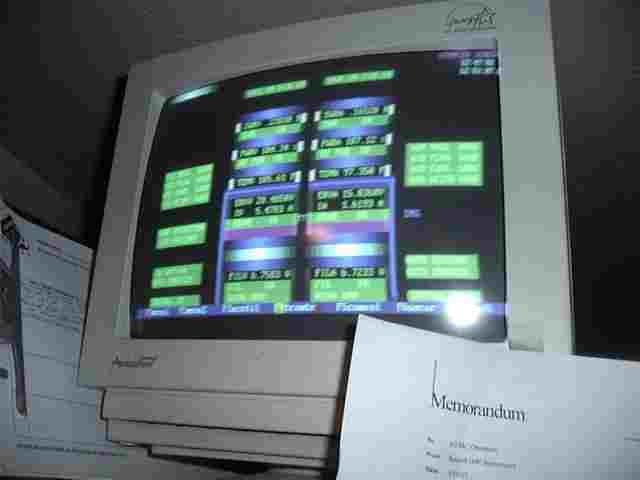 This display is from an old DOS machine. Notice that there exists no real graphics. The graphic illusion is given
by the extended character set of DOS. (One can visualize cylinder looking graphics.) The old programs can run on 33MHz, 66MHz, and 133MHz machines, utilizing four simultanious serial ports and two
parrallel ports (one for printing and one for speech). And with polling, keyboard input is handled quite well. Most of the real work-hourse programming was written in assymbly, and is neccessary
because of the slow machines in which the program dwells. There are several Dos machines, that I know of, that are still running fine, with many years of good service.
This display is from an old DOS machine. Notice that there exists no real graphics. The graphic illusion is given
by the extended character set of DOS. (One can visualize cylinder looking graphics.) The old programs can run on 33MHz, 66MHz, and 133MHz machines, utilizing four simultanious serial ports and two
parrallel ports (one for printing and one for speech). And with polling, keyboard input is handled quite well. Most of the real work-hourse programming was written in assymbly, and is neccessary
because of the slow machines in which the program dwells. There are several Dos machines, that I know of, that are still running fine, with many years of good service.
Today programs are run on windows machines with real graphics and require speeds above 500MHz and RAM above or equal to 256K.

 Displayed is a "menu1" or operator-menu.
Displayed is a "menu1" or operator-menu.
Menu1 is written for Dos machines.

 Another early menu1 was simular, also originaly written for Dos.
Another early menu1 was simular, also originaly written for Dos.
Simular layout is maintained. Individual stations can tailer menues to their needs.

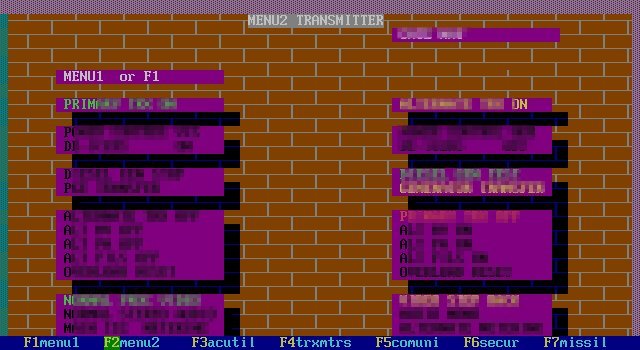 A Menu2 or "transmitter" menu is generic for "F2" function key.
A Menu2 or "transmitter" menu is generic for "F2" function key.
This paticular Menu2 is about 1994, and is also in Dos with animation and illusion of graphics.

 A Dos transmitter menu (No longer used).
A Dos transmitter menu (No longer used).
Notice in the Dos version, controles are on a menu screen, and not on a screen that contains the actual equipment.


SCREENS for WIN98, WIN2000 (WINDOWS DEVELOPMENT)
 TOP SCREEN:
TOP SCREEN:
There are many screens representing specific equipment.
Usually one screen is devoted to one piece of equipment or area of control. This is what I have called the Center Screen or top screen, and it has the focus.
 All screens lay on the back-ground screen shown in blue. But the center screen may be one of many. You can have hundreds of center screens, each signifing a different area of control. The most
important screens are brought up by the function keys. Other screens are brought up by typing words or hot keys. In windows 2000 and above the screens can also be expanded from the windows bottom
task bar. This feature is not available on windows 98.
All screens lay on the back-ground screen shown in blue. But the center screen may be one of many. You can have hundreds of center screens, each signifing a different area of control. The most
important screens are brought up by the function keys. Other screens are brought up by typing words or hot keys. In windows 2000 and above the screens can also be expanded from the windows bottom
task bar. This feature is not available on windows 98.
 DISCOURSE MODE:
DISCOURSE MODE:
All screens can also be brought up by discourse mode. You type a question or word or pneumonic, and the program will give you a screen.
Discourse mode is entered any time a non-function key is pressed.
(Shown is an AC TRANSFER AND GENERATOR screen.)
Center screens may appear (recieve the focus) automatically or manually.
 SCREEN RESERVATION:
SCREEN RESERVATION:
If an operator has used the keyboard or mouse within the last 30 seconds, then the screen is reserved and will not automatically switch. However there will be a quick "flash" to another screen,
indicating to the operator that an event has happened on another screen. This approach was first developed for the old dos systems. It worked well, and I kept the approach, no matter what the
operating system. I invented this approach in 1993 and is proven to be very effective and user friendly.
 SPEECH:
SPEECH:
 The animated talking face in the top right corner indicates that speech is being enunciated. When the mouth stops animation, speech has stopped, and the face will disapear.
The animated talking face in the top right corner indicates that speech is being enunciated. When the mouth stops animation, speech has stopped, and the face will disapear.

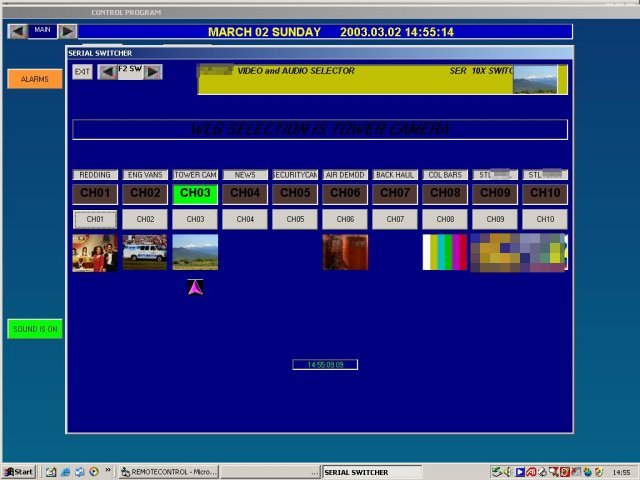 Here is another screen recieving the attention: a switcher.
Here is another screen recieving the attention: a switcher.
Notice there exists atleast one alarm because the alarm bar is in orange. And it has been acknowledged. If there are no alarms the bar is in green. No matter which screen is displayed the alarm
button and speech button are always in view.
This represents a generic switcher. You choose an icon to represent a channel, and you connect whatever video and audio to the back of the switcher. The software that I wrote operates both
grassvalley and videotek switchers. The display remains the same no matter what switcher is actually employed.
An operator can select a channel by the mouse or by a numeric key. The display will not give an indication of a switch until temlemetry from the remote site verifies that the switch actually took
place. The output shows the selected channel.
There are modern switchers that actually show you a small window of real video contained on the channel. These switchers are really neat. But here we are dealling with old surplus switchers that
you can buy on ebay for $50 or less.

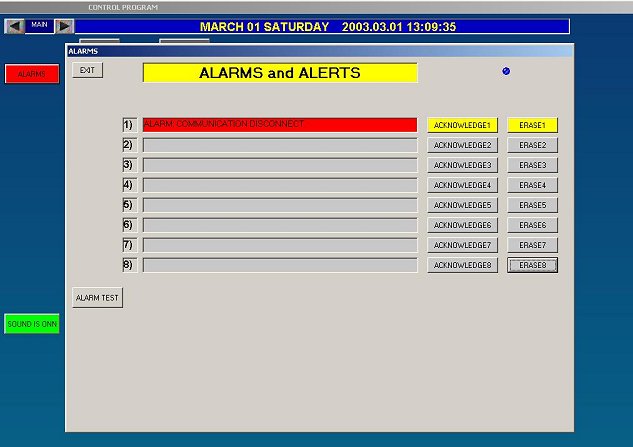
 The alarm pannel:
The alarm pannel:
In the blue backgroud, is a bar: visiable to all screens. If the bar is red, then there exists atleast one alarm that has not been acknowledged. There are eight possible different alarms. Each
alarm has a unique identifier, and Repeats are discounted.
If the operator fails to acknowledge any alarm, then every minute at the top of the minute, a vocal will re-proclaim the alarm.

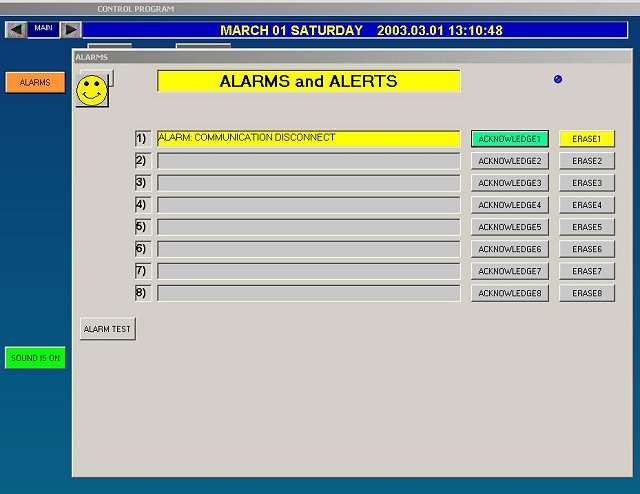 Once an alarm is acknowledged, any further incidences involving that alarm will not be processed. However, further alarms will still be documented to the disk and paper logs. The displayed alarms
are therefore an operator alarm pannel.
Once an alarm is acknowledged, any further incidences involving that alarm will not be processed. However, further alarms will still be documented to the disk and paper logs. The displayed alarms
are therefore an operator alarm pannel.
If an operator erases an alarm, and that alarm reaccures, then the alarm will re-activate.
 Alarms are required by the FCC.
Alarms are required by the FCC.

 (Here is an example of a transmitter screen.)
(Here is an example of a transmitter screen.)
 SAME SCREEN: CONTROLES and TELEMETRY
SAME SCREEN: CONTROLES and TELEMETRY
Notice all controls are located on the same screen as the telemetry. The controlling functions are in the center of the screen, and flash in color as the function is being executed at the remote
site. The results of the action can immediately be seen on the same screen.
Over the years, as a programmer, I have observed operators preferring this approach.
 VISUAL TRANSMITTER MODULE
VISUAL TRANSMITTER MODULE

 (Another klystron analog transmitter screen:)
(Another klystron analog transmitter screen:)
 FAST IDENTIFICATION:
FAST IDENTIFICATION:
Notice the background picture is obscured with a squirrelly pattern. The picture is only a representation of the front of a transmitter. You can choose whatever background that you wish. But to
keep the display user friendly, you should choose something obvious. If your background contains actual meters, you should obscure them in a paint program before placing the background.
The operator is denied reading the meters in this picture. However, it is very possible to put an actual real-time picture in the background.
Most remote control communication links have limited bandwidth. A real live picture, therefore, would appear jerky. One would purchase a video digitizer (about $50), and digitize the real image to
a jpg. The program would take the most recent image. The image would be ready perhaps every 10 seconds. The image would be imported into the background. 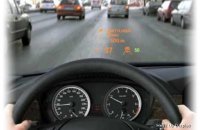 When I was in the Air Force, fighter jets had what was called HUD (Heads Up Display).
On the F4's, you could see the real world through a piece of plastic, but projected also on that plastic was data and computer graphics: digested, and augmenting the real world image. One could
see target information altitude, horizon, and such. It would be the same with my hypothetical control display. One would see an image of what one was being controlled, as well as condensed
representations. The military has this now, but no one has built such a display in a control program. Perhaps you share the same vision and frustrations. Drop me a note for moral support.
When I was in the Air Force, fighter jets had what was called HUD (Heads Up Display).
On the F4's, you could see the real world through a piece of plastic, but projected also on that plastic was data and computer graphics: digested, and augmenting the real world image. One could
see target information altitude, horizon, and such. It would be the same with my hypothetical control display. One would see an image of what one was being controlled, as well as condensed
representations. The military has this now, but no one has built such a display in a control program. Perhaps you share the same vision and frustrations. Drop me a note for moral support.
 AURAL TRANSMITTER MODULE
AURAL TRANSMITTER MODULE

 Here is an example of a screen that needs cosmetic work: An AC Transfer and Generator screen.
Here is an example of a screen that needs cosmetic work: An AC Transfer and Generator screen.
Everything works good on the screen but the screen has cosmetic problems. For example, the picture of the PGE POLE does nothing and signifies nothing.
You can change the look very easily with Visual Basic, or Visual Net. There is no problem in creating or changing these screens.
A company should have a person knowledgeable in programming to make this type of change. This approach is opposite of most commercial programs. Commercial programs require a very confusing set of
instructions to make the simplest change. Changes to programs are simpler in the native programming language. It is harder to verse an operator in such a "removed, abstract, and indirect" procedure
that is actually more complicated.
 AC TRANSFER AND GENERATOR MODULE
AC TRANSFER AND GENERATOR MODULE

 Here is an example of another screen, showing a lot of temperatures.
Here is an example of another screen, showing a lot of temperatures.
Back-ground is showing heat exchangers. And guess what, it is a heat exchanger screen.
 MOST RECENT EVENT:
MOST RECENT EVENT:
Across every center screen is a Most Recent Event bar.
In this example, the bar reads "HEAT EXCHANGER AUTOMATICS OFF". This bar is shown in transparent background, which probably is not the best choice. The operator can not change this, but the
programmer can change this so very easily.
 HEAT EXCHANGERS MODULE
HEAT EXCHANGERS MODULE

A SELECTOR screen.
I am sorry, I can't show this type of screen as it may contain some aspects of security. What I can say about this type of screen is that an ordinary switcher is transformed into an "intellegent"
switcher by connecting to my net which containes security events. Ordinary, off the shelf switchers, when connected to an intellegent net such as mine are transformed into autonomous machines.
 RESTRICTED SWITCHER MODULE
RESTRICTED SWITCHER MODULE
 GENERIC INFO ABOUT SWITCHER MODULES
GENERIC INFO ABOUT SWITCHER MODULES

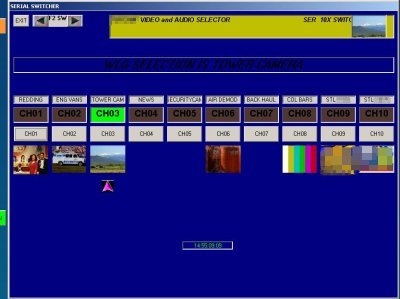 TSL SELECTOR screen.
TSL SELECTOR screen.
Even if all positions are used, not all positions have to have a nice logo picture. What ever logo picture is under the button, that picture moves to the output selection. Show is position three:
the TOWER CAM. Selections can be made with the mouse or keys.
 RESTRICTED SELECTOR MODULE
RESTRICTED SELECTOR MODULE
 RESTRICTED COHASSET SELECTOR MODULE
RESTRICTED COHASSET SELECTOR MODULE
 RESTRICTED COHASSET BACK HAUL SWITCHER MODULE
RESTRICTED COHASSET BACK HAUL SWITCHER MODULE
I created a remote stand-alone pannel with push buttons.
One can push a button to activate a switcher many miles away with out a computer.
 RESTRICTED REDDING REMOTE SELECTOR MODULE
RESTRICTED REDDING REMOTE SELECTOR MODULE
 RESTRICTED ENG FREQUENCY CONTROL MODULE
RESTRICTED ENG FREQUENCY CONTROL MODULE

CognizantWire Systems
![]()